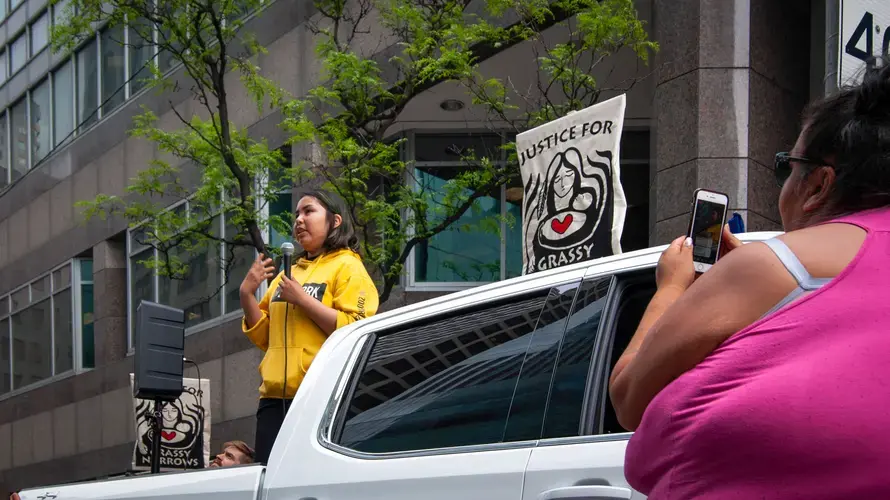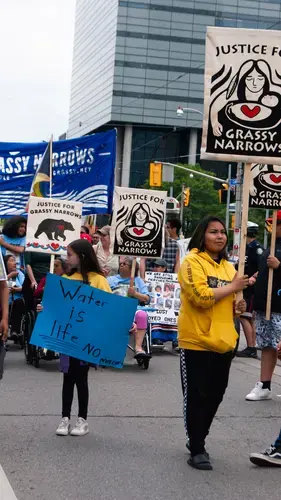
For almost 50 years, Grassy Narrows First Nation in Ontario, Canada, has been forced to deal with mercury poisoning as a result of industrial pollution. For almost the same amount of time, the people of Grassy Narrows have been engaged in acts of protest and resistance with the intention of regaining the health and autonomy of their traditional lands.
From engaging in letter-writing campaigns, to participating in hunger strikes, and everything in between, the people of Grassy Narrows First Nation have employed a number of tactics to fight for their community.
The River Run event—a march through Toronto intended to draw attention to the struggles faced by Grassy Narrows—on June 20, 2019, was just the tip of the community’s activism iceberg. But, it provides young activists in the community with a stage where their voices can be heard.

At the River Run event, young people in the community were given the opportunity to lead the march through the streets of downtown Toronto and advocate for their community.

Youth activism has become the norm for this community of fighters. Like many others, Chrissy Isaacs, now a 39-year-old vocal activist for her community, started her activism career at a young age.
“I started in the 1990s when I was just a teenager. We did the blockade for Grassy to stop the clear cutting. I started speaking out about all of the environmental racism in our traditional territory,” said Isaacs in an interview following the River Run event.
One of the most prominent moves Isaacs made as a young activist was her participation in her community’s logging blockade. In 2002, in a youth-led movement, Grassy Narrows established a blockade on a prominent logging road with the hopes of ending the clearcutting on their traditional lands. In 2017, the provincial government forbade logging in the area until 2022, but the Grassy Narrows community is ready to re-establish their blockade if necessary.

Isaacs believes the youth of today are also keenly aware of the issues that face their community.
“I think that for the young people, they are very aware of what’s going on in our community," said Isaacs. "And that's a really good thing because when I was younger I had questions. I remember being 8 years old and wondering and just asking, ‘Why do we live like this?’”

One of the Grassy Narrows youths to speak at the River Run event was Paris Meekis, a Grassy Narrows teenager.
“Holy moly! There’s so many people,” began Meekis with a bit of a laugh. “I’ve lived in Grassy Narrows my whole life and just seeing that we have so much support out here it makes me happy,” she continued, speaking before a crowd of supporters.

“For years now we’ve been ignored. The government didn’t want to do anything about it. We’ve suffered so much and I don’t think we should suffer much longer. We need a change now. We need a future. A brighter, better future for our future children. Future generations, our brothers, our sisters, everybody that’s here,” said Meekis.

Another Grassy Narrows youth who spoke, Jenae Turtle, seemed a bit more nervous in her delivery, but was just as strong in her convictions.
“Where’s that mercury [care] home that the government promised us a long time ago? We’ve been fighting for a long time and nothing has been done,” said Turtle, as her voice shook. “We’ve been talking a lot but no one has done anything about it.”

In addition to being given a speaking platform, the Grassy Narrows youth led the march through Toronto. Whether they spoke in front of crowds or just marched alongside their community members, the youth of Grassy Narrows are ready to take on the fight.

“Our voice matters,” said Turtle, with little tinge of the nervousness heard previously.

While the youth are ready to be heard, the need for them to be heard is heartbreaking for some, including Isaacs.
“Today, the young people that spoke—that touched my heart—but at the same time it broke my heart because the young ones shouldn’t have to fight. This should have been dealt with a long time ago.”





